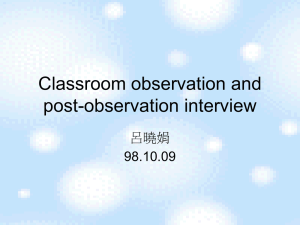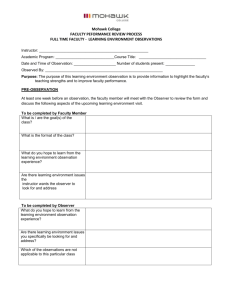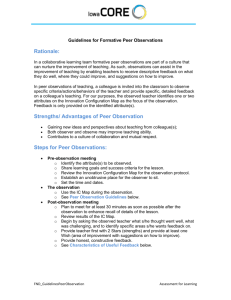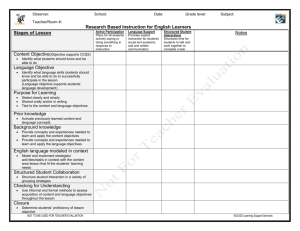Peer observation for distance learning tutors: pro forma & guidance
advertisement
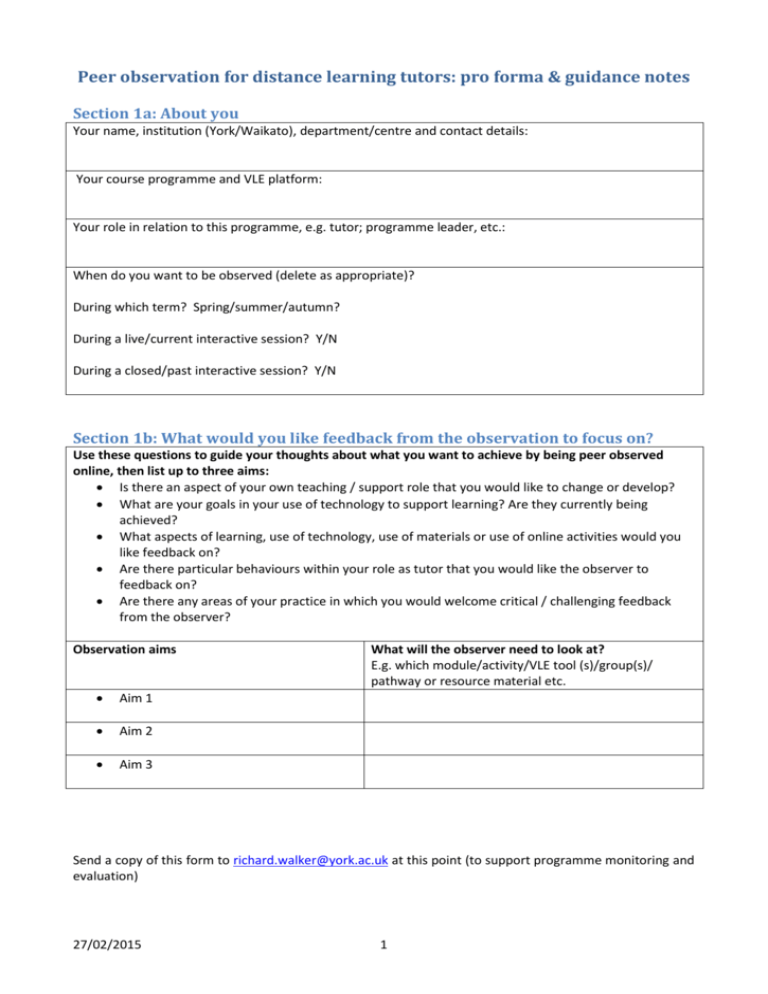
Peer observation for distance learning tutors: pro forma & guidance notes Section 1a: About you Your name, institution (York/Waikato), department/centre and contact details: Your course programme and VLE platform: Your role in relation to this programme, e.g. tutor; programme leader, etc.: When do you want to be observed (delete as appropriate)? During which term? Spring/summer/autumn? During a live/current interactive session? Y/N During a closed/past interactive session? Y/N Section 1b: What would you like feedback from the observation to focus on? Use these questions to guide your thoughts about what you want to achieve by being peer observed online, then list up to three aims: Is there an aspect of your own teaching / support role that you would like to change or develop? What are your goals in your use of technology to support learning? Are they currently being achieved? What aspects of learning, use of technology, use of materials or use of online activities would you like feedback on? Are there particular behaviours within your role as tutor that you would like the observer to feedback on? Are there any areas of your practice in which you would welcome critical / challenging feedback from the observer? Observation aims Aim 1 Aim 2 Aim 3 What will the observer need to look at? E.g. which module/activity/VLE tool (s)/group(s)/ pathway or resource material etc. Send a copy of this form to richard.walker@york.ac.uk at this point (to support programme monitoring and evaluation) 27/02/2015 1 Section 2a: Observation and feedback arrangements - observer’s name Your name, department/centre and contact details: Section 2b: How will the observation be conducted and feedback shared? To be agreed directly between you and your observer. When will the observation take place (approximate start and finish dates)? Is any clarification of your observation aims needed? E.g. to enable your observer to address them? Is any clarification of the things that need to be looked at needed? E.g. does this involve real time synchronous discussion, a current ‘live’ asynchronous discussion or a closed asynchronous discussion? How does your observer gain access to your programme / module / discussions? Is there anything else that your observer needs or wants to know before the observation begins? Have you informed students that the observation is taking place and an external observer will be visiting the course site? (for ‘live’ course) When and how will feedback be shared? E.g. face to-face, by phone, in writing, a combination, etc. Section 3: Observer and person being observed How will feedback/observations be used to inform future teaching? How will feedback / observations be used to inform your own teaching? How will feedback / observations be used to inform others teaching? E.g. those who teach on the same programme or module, those who teach on other programmes, etc? How will lessons learned be taken forward beyond personal actions? E.g. lessons learned by both observer the person being observed, examples of good or innovative practice observed, ideas for the development of the technology in use or module design? 27/02/2015 2 Guidance notes Principles of peer observation Peer observation is primarily a developmental technique for the individuals involved. It facilitates the sharing of impartial and objective feedback based upon actual observations of teaching practice in order to: Enable the person being observed to better understand their behaviours and actions whilst teaching and so make informed decisions about how to behave and act differently in order to become a better teacher; Enable the observer to objectively describe and discuss the behaviours and actions of other teachers and to be informed by these observations. This will include the identification and sharing of good or innovative practices; and Enable diverse and innovative teaching methods and practices, including use of technology, to be opened up to external friendly scrutiny and discussion, in order to ensure that good and innovative practices are shared. The person being observed owns the process in order to have confidence in it; hence self-selecting the materials to be observed, the timeframe of the observation and the aims of the observation are key. Section 1 of the pro-forma encourages the person being observed to think deeply about what they require feedback on, why they want it and where the evidence is likely to be located. Ideally both parties should meet prior to the observation to exchange the information set out in section 2 of the pro-forma, which should be seen as a prompt rather than as a checklist. Context information refers to any important information about the group/activity/course that the observer will need to consider during the observation. This might include: The balance of online/face-to-face activities How the online activity/work fits into the overall course (timing / assessment criteria) Student mix Particular challenges and past experience Focus for the observation The person being observed may wish to reflect on the following questions to guide their thoughts about what they want to explore through peer observation: What are your goals in your use of technology and teaching approaches to support students’ learning? Are they currently being achieved? What aspects of student online learning and use of technology would be most interesting for you to explore and why? Is there an aspect of your own online teaching and/or support role that you would like to change or develop? Are there particular aspects of your use of the technology, your online materials and/or the online activity that you would like feedback on? (Note: this might be to understand better why something works well as much as something that is not working successfully.) Are there aspects of your role as tutor that you would like the observer to focus on? Select 2 or 3 specific areas, which might cover one of the following issues: 27/02/2015 3 Materials, instructions & broader design issues: e.g. site structure / materials presentation; content of online materials – level and clarity; overall course design. Tutor online activity: e.g. management of the online activity; tutor input into / contribution within student online discussion (quantity & quality); desirable behaviours; styles of questioning / prompting / developing student input; etc. Student engagement in online activity: e.g. amount of student participation; quality of student interaction; depth of student discussion. For example, an observee might identify a perceived problem with students’ engagement with a discussion exercise e.g. exhibiting behaviour such as the ‘yes man’ format or the ‘post and run' or mini-essay, format within a discussion board activity. A guided observation might help to identify: - the level and nature of interaction between tutor and student group? E.g. which behaviours encourage and discourage interaction? where to begin if the group has already started...”sometimes I wonder if they actually need me to say anything at all but I feel compelled to make a posting just to highlight that I am here” whether there is a student to student problem and, if so, whether and how it may be addressed. For further ideas on themes for the observation, please take a look at the record of issues explored by participants from the 2011 trial programme, which are set out in the Appendix to this document. Don’t forget: The observee should provide advice to the observer on where to look for evidence. Please also consider your students. If you wish to use a ‘live’ module site as the basis for the observation, your students should be informed about the presence of an external observer in the course site and the observer’s role, addressing the rationale for the observation that will be taking place. Delivering feedback to the observee Ideally feedback should be shared face to face, in private, where possible. The observer should seek to use non-judgemental language, which helps to foster a mutual learning process between observee and observer. Note taking during the observation would take the form of “I noticed …. and I wondered / thought / wanted to ask you…” and should be supported by actual examples. Both those being observed and those doing the observing should be prepared and plan to practise what they learn as individuals, but also to share their learning with their immediate team colleagues and the wider distance learning community, including colleagues who support distance learning such as the eLearning team. Post-observation evaluation Both observers and those being observed will be asked to participate in the post-observation evaluation process, which has been established to identify improvements for future programmes. It is assumed that participation in the programme is tacit acceptance of a willingness to do so. No confidences will be broken in doing so. 27/02/2015 4 APPENDIX Observation themes explored in York peer observation programmes (2011-14) Theme Reported outcomes & issues under consideration Theme 1: Discussion Management Discussion management & organisation: Encouraging student participation Rounding off discussions Responding when issues arise Methods for supporting student learning Balance of feedback to individuals & group Handling overassertive students. Learning when to intervene and when to back off. Techniques for controlling focus & pace of discussion Participation requirements for group discussion Managing discussions – techniques & language Techniques for setting boundaries / ground rules for discussion Strategies for drawing out quieter students Strategies for assessing group discussion Developing 1:1 support provision Bringing students into discussion / closing discussions Supervision techniques Developing provision for weaker students Contribution of posts to discussion Value of tutor’s input to discussion Tone & delivery of feedback Length / style of tutor’s posts Balance between teaching & facilitation Reflection on tutoring style Methods for stimulating group interaction Stimulating student – student interaction Managing group interaction Posing questions which really engage students Feedback techniques to individual & group Use of humour Injecting challenge into postings – inviting students to justify their viewpoints Design of tasks to stimulate student: student interaction Learning when to respond to a group rather than to individuals Tone & emotion in tutoring interventions Style vs. substance in tutoring interventions Theme 2: Course design Course content Building engaging materials Presentation & content of course Activity design Balance of tasks (individual vs. group) and use of media 27/02/2015 Introduce video ‘talking heads’; create personal stamp on course Different use of resources Introduction of individual tasks as springboard for 5 Tips on improving visual structure of module Set up of discussions Peer review exercises. learning. Expectations made of students Replacing discussion tasks with research exercises to encourage background reading. Time allocation and preparatory study activities. Tips on structure and pacing of task – what to do and when. Being explicit in task design Scaffolding learners to look for different perspectives in literature Balance between personal reflective activities and discussion board postings. Induction provision Interaction space and Scope of induction (available communication materials & technology; allocated channels time) Theme 3: Tutor’s skills (general) Language development Use of language with non-English language native speakers Pastoral support Time management Managing delivery of feedback to students Technology usage Alternative tools / delivery modes Getting the right balance between academic guidance & pastoral support Rotating mode of feedback delivery (audio vs. written feedback) between groups Role & purpose of spaces: discussion & coffee areas Difference between Bb & Moodle Wikis to manage smaller group discussion Use of web conferencing – when and how to do this. Use of media & emoticons Technology help & guidance Layout of blog / forum discussion space Theme 4: Programme management Supporting associate tutors Supporting & monitoring associate tutors Quality assurance procedures 27/02/2015 6 Difference between Bb & Moodle & ‘adaptive release’ Use of Twitter as starting point for pacing and structure of assessment responses. Emergent themes Miscellaneous Support for overseas students Preparation for writing at Masters level Modularisation 27/02/2015 7 Helping students to build their own social media presence. Delivering audio feedback through podcasts.

